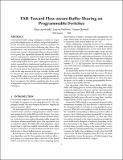FAB: Toward Flow-aware Buffer Sharing on Programmable Switches
Author(s)
Ranjan, Manya
DownloadAccepted version (2.636Mb)
Open Access Policy
Open Access Policy
Creative Commons Attribution-Noncommercial-Share Alike
Terms of use
Metadata
Show full item recordAbstract
Conventional buffer sizing techniques consider an output port with multiple queues in isolation and provide guidelines for the size of the queue. In practice, however, switches consist of several ports that share a buffering chip. Hence, chip manufacturers, such as Broadcom, are left to devise a set of proprietary resource sharing algorithms to allocate buffers across ports. This algorithm dynamically adjusts the buffer size for output queues and directly impacts the packet loss and latency of individual queues. We show that the problem of allocating buffers across ports, although less known, is indeed responsible for fundamental inefficiencies in today's devices. In particular, the per-port buffer allocation is an ad-hoc decision that (at best) depends on the remaining buffer cells on the chip instead of the type of traffic. In this work, we advocate for a flow-aware and device-wide buffer sharing scheme (FAB), which is practical today in programmable devices. We tested FAB on two specific workloads and showed that it can improve the tail flow completion time by an order of magnitude compared to conventional buffer management techniques.
Date issued
2019-12Department
Massachusetts Institute of Technology. Computer Science and Artificial Intelligence LaboratoryJournal
BS '19 Proceedings of the 2019 Workshop on Buffer Sizing
Publisher
ACM
Citation
Apostolaki, Maria et al. “FAB: Toward Flow-aware Buffer Sharing on Programmable Switches.” Paper in the BS '19, Proceedings of the 2019 Workshop on Buffer Sizing, Palo Alto, Calif., December 2019, ACM: 1-6 © 2019 The Author(s)
Version: Author's final manuscript
ISBN
9781450377454